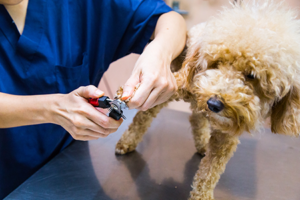
Here’s everything you need to know about trimming your dog’s nails safely and easily:
Understanding Your Dog’s Nails
A dog’s nails are made up of two separate parts: the nail itself (the hard outer shell) and the quick (the pink inner blood vessel). As the nail grows, the quick grows too; if the quick becomes too long, it may be difficult or impossible to trim your dog’s nails back down to a healthy length.
When a dog’s nails grow too long, they can curl under and hamper the dog’s ability to walk, run and play. This may cause lasting pain and other issues for your pup. Excessively long nails are also more likely to break or catch on things, which could cause the nail to be torn off.
Regular nail trimming will cause the quick to recede to a comfortable and healthy length and is the key to good nail hygiene. Some dogs naturally wear their nails down by playing on rough surfaces, and won’t need to have them trimmed as frequently.
There are several types of nail trimmers to choose from, such as scissors, guillotine-style clippers, and grinders. Choose whichever tool you feel most comfortable using.
How to Trim Your Dog’s Nails
- Make sure both you and your dog are in a comfortable position. It may help to have a second person who can assist by restraining your dog (if needed) or offering treats.
- If your dog has light-colored nails, it will be easier to see the quick through the nail. Make sure you do NOT cut into the quick, as it’s very sensitive and tends to bleed a lot when cut. Holding your dog’s paw up to a light may help you see the quick more easily.
- Hold your dog’s paw gently yet firmly, then snip off a small bit from the end of the nail. In this case, trimming too little is preferable to trimming too much. If you encounter any spongy material while trimming, stop immediately – you’re cutting into the quick.
- If you do cut into the quick, don’t be surprised if you see a large quantity of blood. The styptic powder can be useful for stopping the bleeding; at a minimum, wrap your dog’s paw in a clean cloth or paper towel until the bleeding has ceased.
- Don’t forget to trim the dewclaws, which are located on the inner side of the paw. The dewclaws do not touch the ground, which means they do not experience any natural wear-and-tear. If left untrimmed, the dewclaw may grow into your dog’s soft tissue.
- You’re all done! Offer plenty of praise, petting and treats to your pup for their good behavior.
Tips for Trimming Your Dog’s Nails
Many dogs naturally dislike having their nails and paws handled, so it’s a good idea to get your pup comfortable with this process from an early age. If your puppy or dog is especially reluctant to have their nails trimmed, it’s okay to start slow.
Begin by letting them sniff the nail clipper or grinder, then praise them and give them a treat. You may need to repeat this step over the course of several days. When your dog seems comfortable with the nail clipper, try touching it to each of their feet. Again, offer rewards for good behavior and repeat this step as many times as needed.
Finally, it’s time to trim your dog’s nails. You may need to start with one paw – or even one nail – at a time to keep your dog from becoming overwhelmed and stressed. If it’s your first time cutting your dog’s nails, it’s okay, to begin with trimming just the slightest tip off each nail.
Keep offering treats and praise each and every time you trim your dog’s nails. Allowing your pup to lick peanut butter off a spoon may help keep them distracted and happy while you trim.
Still have questions or concerns about trimming your dog’s nails? Schedule a consultation with your vet!